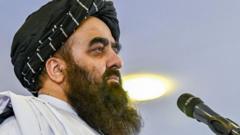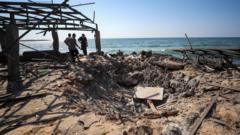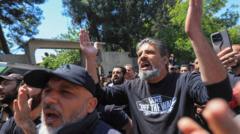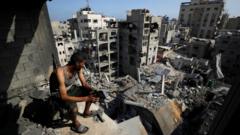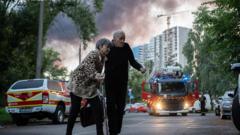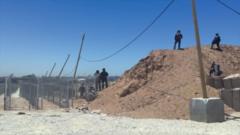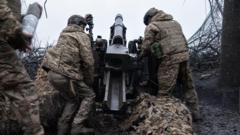In Ukraine's Sumy region, local troops face an incessant barrage of Russian drones, reflecting a cycle of violence and emotional strain. Amidst rising casualties and deteriorating conditions, the soldiers and civilians alike navigate the horrors of war, uncertain about the future.
The Unyielding Struggle: Ukrainian Forces Endure Nightly Drone Warfare
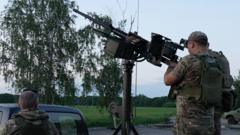
The Unyielding Struggle: Ukrainian Forces Endure Nightly Drone Warfare
As the drone threat looms large, Ukrainian soldiers on the front line grapple with relentless aerial attacks, mirroring a tragic 'Groundhog Day' scenario in their daily lives and communities.
In Ukraine's north-eastern Sumy region, local soldiers embody resilience and determination as they confront approximately 100 Russian drones nightly. These troops, armed with weapons from a bygone era, engage in an ongoing aerial contest where they shoot at advanced drones engineered for modern warfare. Commander Jaeger, a former forest ranger turned military leader, leads a local battalion defending not only their hometown but the very fabric of their nation.
Upon arrival at their frontline position, the tension was palpable. As Jaeger monitored red dots on his screen, an advancing wave of Iranian-made Shahed drones loomed above. The soldiers calculated their strategies, launching bursts of gunfire at the barely-visible targets. The flicker of humor was a brief respite amid the chaos; Jaeger joked about his teammates' superstitions regarding drone attacks, though the gravity of the situation hung heavily in the air.
"I feel sadness, but there’s no time for feelings," Jaeger candidly admitted as explosions erupted around them. "It's like Groundhog Day, same thing every night." Their unit has been designated as a "mobile fire unit," composed of locals driven to protect their cherished landscapes from a persistent enemy. Unfortunately, around a hundred drones per night have become the grim reality of their existence.
As these drones often target Kyiv, the soldiers remained acutely aware of the destructive potential of each flight. On one harrowing night, as the Ukrainian air force logged over 300 drones aimed at the capital, the residents braced for impact. Casualties continued to mount, with the death toll spiking the morning after yet another heavy attack.
Life amidst war has transformed the once vibrant agricultural fields around Sumy into stark reminders of conflict, now punctuated by defensive constructs known as dragon's teeth. Furthermore, the plight of civilians presents harrowing consequences of this aerial warfare. Margaryta, a survivor of a devastating drone strike that claimed her family, recounted her trauma of losing loved ones in an instant. Confronted by persistent air raid sirens, she remains haunted and fearful for the safety of her children.
Discussion of peace feels distant in Sumy; even U.S. policymakers who once envisioned swift resolutions have shifted focus. The soldiers prepared for continuing strife rather than anticipated peace talks, with many expressing doubts about any potential ceasefire lasting more than a temporary pause. As one soldier put it, "President Putin has imperialist ambitions," contrasting the stark realities of broken homes and lost connections as families are torn apart by the months of warfare.
The grim cycle of combat and hope for survival continues as Ukraine braces for the long road ahead amidst an existential threat that has entrenched itself in daily life. With families separated and lives fragmented, the soldiers stand as symbols of resistance, caught in a tragic loop of conflict that shows no signs of abating.


